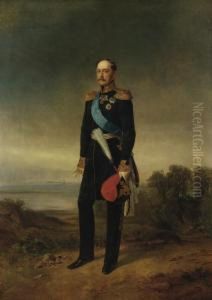Gregor Jnr Von Bochmann Paintings
Gregor von Bochmann was a German-Baltic painter primarily known for his landscapes and genre scenes. Born on June 1, 1850, in Dorpat (now Tartu, Estonia), which at the time was part of the Russian Empire, von Bochmann grew up in a region known for its picturesque scenery and cultural diversity. His father, Gregor von Bochmann the Elder, was also a painter, which suggests that he was likely exposed to art and artistic training from a young age.
Von Bochmann studied at the Düsseldorf Academy of Arts, a prominent art school in Germany that attracted many aspiring artists from the Baltic regions. The Düsseldorf school of painting emphasized detailed realism and landscape painting, which had a significant influence on von Bochmann's style. After his studies, he spent most of his career in Germany.
Throughout his career, Gregor von Bochmann was known for his ability to capture the essence of rural life and the natural environment. His work often featured scenes from the countryside, including peasants at work, serene landscapes, and the changing seasons. These paintings were characterized by their vivid detail, careful composition, and a sense of tranquility.
Von Bochmann exhibited his work widely, gaining recognition not only in Germany but also in other parts of Europe. His paintings were well-received for their technical skill and their ability to evoke emotion. Despite the rise of modernist movements at the turn of the century, von Bochmann remained committed to his realist style, which continued to resonate with audiences who appreciated traditional landscape and genre painting.
Gregor von Bochmann passed away on February 24, 1930, in Düsseldorf, Germany. His legacy is maintained through his contributions to the German art scene and the ongoing appreciation of his work in galleries and private collections. His paintings still attract attention from art historians and collectors, and his name is often associated with the Düsseldorf school of painting, which played a significant role in the development of 19th-century European art.
